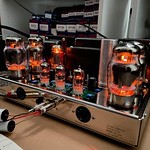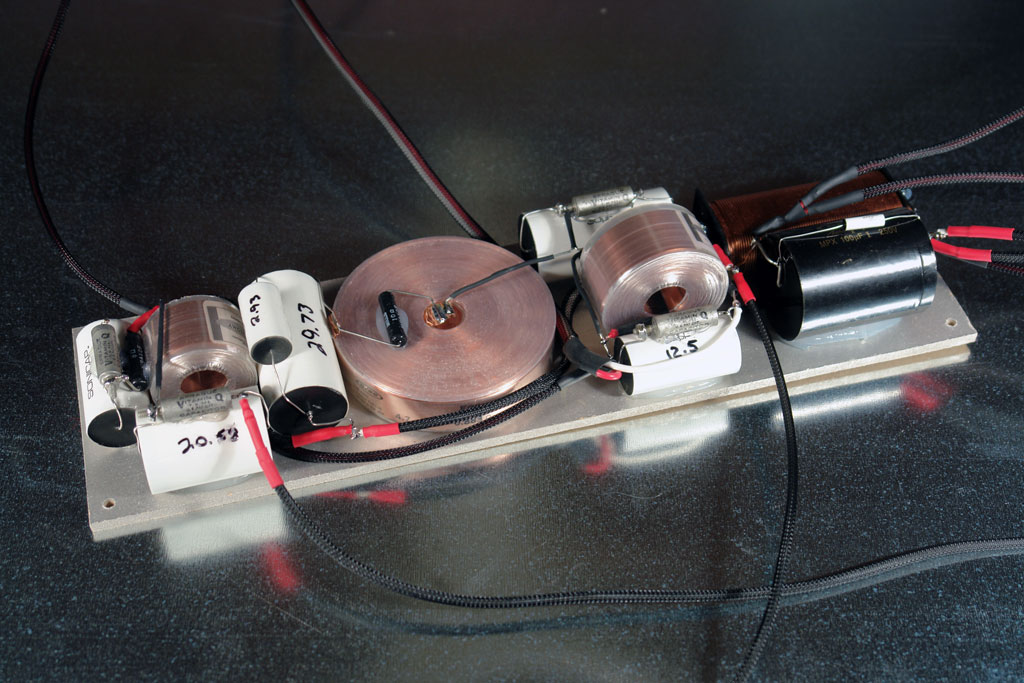I kinda hijacked digdug's thread so I thought I'd start a new one to respond to Skizo's comment.
It's a bit of a mess. I see a few electrolytics. These are not good in speaker crossovers for a couple of reasons. They're typically 20% tolerance to begin with so you lose accuracy there. After about 10 years the electrolytic starts to dry out which increases resistance and throws the specs even further off. A good polypropylene film cap (Erse Pulse X are 3% tolerance and still cheap!) will keep things in spec and resistances low for a long time.
Another area they dropped the ball at is arrangement of the inductors. It may just be because these are older but nowadays the better speaker designers pay close attention to inductor layout due to magnetic field interaction.
If they have to be closer than say 6" then they should be mounted perpendicular to each other as I showed earlier. As shown in your picture they will have a measurable effect and both will be thrown off value. Granted, it may not be a lot but it's this sort of attention to detail that separates a good speaker from a great speaker.

Another thing is the use of iron core inductors. In a low pass circuit they're acceptable as an equivalent air core choke would get pretty expensive (although still superior). They might also be needed for a specific DC resistance. They have no business being in a midrange or tweeter circuit. They can saturate and add distortion to the sound. Air core inductors are the way to go.
Here's a crossover by Thiel for example. I still see electrolytic caps but only a couple and they're likely not in the signal path. No iron core inductors. Nice, clean layout.

Oh and as far as those Paradigm speakers go; they do some things right but still take short cuts. Don't let the price fool you. Remember that's the price of the speakers plus profit, plus dealer margin, plus packaging, etc. The crossovers are almost always the place that gets compromised because they're hidden.
So, if you're up for the challenge, I would recommend getting the schematic for your speakers if possible and getting to work.
sKiZo wrote:
Corndog >> I see your point on the crossovers, but at $1800 each, I'd expect the Paradigm's to be a bit above that sort of encheapening ... then again, hard to tell without looking inside.
PS ... here's the 4way crossovers in my McIntosh XR16's ... they look all right to me ... from what I understand, each coil is custom wrapped for that particular box ... not sure how I'd improve on that, but I'm open to suggestions.
It's a bit of a mess. I see a few electrolytics. These are not good in speaker crossovers for a couple of reasons. They're typically 20% tolerance to begin with so you lose accuracy there. After about 10 years the electrolytic starts to dry out which increases resistance and throws the specs even further off. A good polypropylene film cap (Erse Pulse X are 3% tolerance and still cheap!) will keep things in spec and resistances low for a long time.
Another area they dropped the ball at is arrangement of the inductors. It may just be because these are older but nowadays the better speaker designers pay close attention to inductor layout due to magnetic field interaction.
If they have to be closer than say 6" then they should be mounted perpendicular to each other as I showed earlier. As shown in your picture they will have a measurable effect and both will be thrown off value. Granted, it may not be a lot but it's this sort of attention to detail that separates a good speaker from a great speaker.

Another thing is the use of iron core inductors. In a low pass circuit they're acceptable as an equivalent air core choke would get pretty expensive (although still superior). They might also be needed for a specific DC resistance. They have no business being in a midrange or tweeter circuit. They can saturate and add distortion to the sound. Air core inductors are the way to go.
Here's a crossover by Thiel for example. I still see electrolytic caps but only a couple and they're likely not in the signal path. No iron core inductors. Nice, clean layout.

Oh and as far as those Paradigm speakers go; they do some things right but still take short cuts. Don't let the price fool you. Remember that's the price of the speakers plus profit, plus dealer margin, plus packaging, etc. The crossovers are almost always the place that gets compromised because they're hidden.
So, if you're up for the challenge, I would recommend getting the schematic for your speakers if possible and getting to work.










